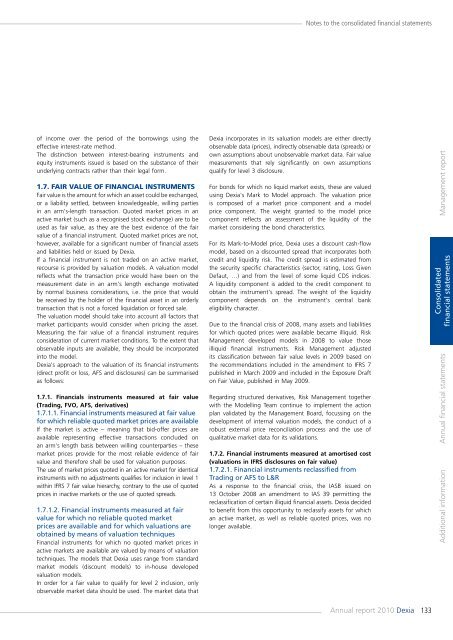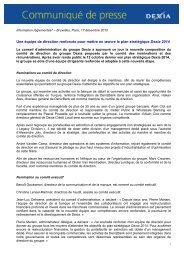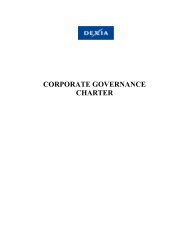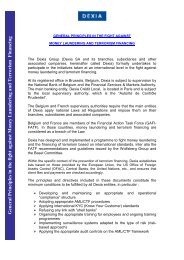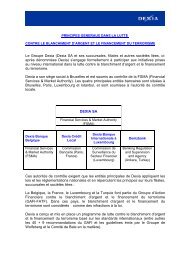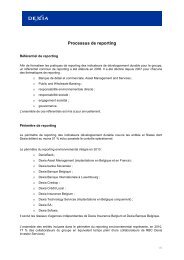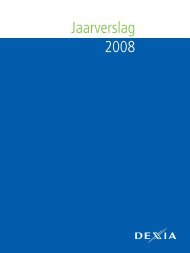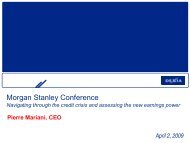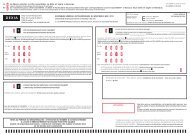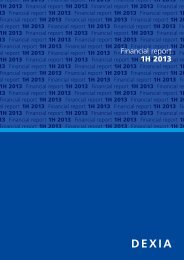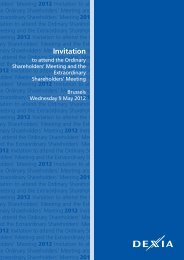Annual report 2010 - Dexia.com
Annual report 2010 - Dexia.com
Annual report 2010 - Dexia.com
- No tags were found...
You also want an ePaper? Increase the reach of your titles
YUMPU automatically turns print PDFs into web optimized ePapers that Google loves.
Notes to the consolidated financial statementsof in<strong>com</strong>e over the period of the borrowings using theeffective interest-rate method.The distinction between interest-bearing instruments andequity instruments issued is based on the substance of theirunderlying contracts rather than their legal form.1.7. FAIR VALUE OF FINANCIAL INSTRUMENTSFair value is the amount for which an asset could be exchanged,or a liability settled, between knowledgeable, willing partiesin an arm's-length transaction. Quoted market prices in anactive market (such as a recognised stock exchange) are to beused as fair value, as they are the best evidence of the fairvalue of a financial instrument. Quoted market prices are not,however, available for a significant number of financial assetsand liabilities held or issued by <strong>Dexia</strong>.If a financial instrument is not traded on an active market,recourse is provided by valuation models. A valuation modelreflects what the transaction price would have been on themeasurement date in an arm's length exchange motivatedby normal business considerations, i.e. the price that wouldbe received by the holder of the financial asset in an orderlytransaction that is not a forced liquidation or forced sale.The valuation model should take into account all factors thatmarket participants would consider when pricing the asset.Measuring the fair value of a financial instrument requiresconsideration of current market conditions. To the extent thatobservable inputs are available, they should be incorporatedinto the model.<strong>Dexia</strong>'s approach to the valuation of its financial instruments(direct profit or loss, AFS and disclosures) can be summarisedas follows:1.7.1. Financials instruments measured at fair value(Trading, FVO, AFS, derivatives)1.7.1.1. Financial instruments measured at fair valuefor which reliable quoted market prices are availableIf the market is active – meaning that bid-offer prices areavailable representing effective transactions concluded onan arm's length basis between willing counterparties – thesemarket prices provide for the most reliable evidence of fairvalue and therefore shall be used for valuation purposes.The use of market prices quoted in an active market for identicalinstruments with no adjustments qualifies for inclusion in level 1within IFRS 7 fair value hierarchy, contrary to the use of quotedprices in inactive markets or the use of quoted spreads.1.7.1.2. Financial instruments measured at fairvalue for which no reliable quoted marketprices are available and for which valuations areobtained by means of valuation techniquesFinancial instruments for which no quoted market prices inactive markets are available are valued by means of valuationtechniques. The models that <strong>Dexia</strong> uses range from standardmarket models (discount models) to in-house developedvaluation models.In order for a fair value to qualify for level 2 inclusion, onlyobservable market data should be used. The market data that<strong>Dexia</strong> incorporates in its valuation models are either directlyobservable data (prices), indirectly observable data (spreads) orown assumptions about unobservable market data. Fair valuemeasurements that rely significantly on own assumptionsqualify for level 3 disclosure.For bonds for which no liquid market exists, these are valuedusing <strong>Dexia</strong>'s Mark to Model approach. The valuation priceis <strong>com</strong>posed of a market price <strong>com</strong>ponent and a modelprice <strong>com</strong>ponent. The weight granted to the model price<strong>com</strong>ponent reflects an assessment of the liquidity of themarket considering the bond characteristics.For its Mark-to-Model price, <strong>Dexia</strong> uses a discount cash-flowmodel, based on a discounted spread that incorporates bothcredit and liquidity risk. The credit spread is estimated fromthe security specific characteristics (sector, rating, Loss GivenDefaut, …) and from the level of some liquid CDS indices.A liquidity <strong>com</strong>ponent is added to the credit <strong>com</strong>ponent toobtain the instrument's spread. The weight of the liquidity<strong>com</strong>ponent depends on the instrument's central bankeligibility character.Due to the financial crisis of 2008, many assets and liabilitiesfor which quoted prices were available became illiquid. RiskManagement developed models in 2008 to value thoseilliquid financial instruments. Risk Management adjustedits classification between fair value levels in 2009 based onthe re<strong>com</strong>mendations included in the amendment to IFRS 7published in March 2009 and included in the Exposure Drafton Fair Value, published in May 2009.Regarding structured derivatives, Risk Management togetherwith the Modelling Team continue to implement the actionplan validated by the Management Board, focussing on thedevelopment of internal valuation models, the conduct of arobust external price reconciliation process and the use ofqualitative market data for its validations.1.7.2. Financial instruments measured at amortised cost(valuations in IFRS disclosures on fair value)1.7.2.1. Financial instruments reclassified fromTrading or AFS to L&RAs a response to the financial crisis, the IASB issued on13 October 2008 an amendment to IAS 39 permitting thereclassification of certain illiquid financial assets. <strong>Dexia</strong> decidedto benefit from this opportunity to reclassify assets for whichan active market, as well as reliable quoted prices, was nolonger available.Management <strong>report</strong>Consolidatedfinancial statementsAdditional information <strong>Annual</strong> financial statements<strong>Annual</strong> <strong>report</strong> <strong>2010</strong> <strong>Dexia</strong>133


